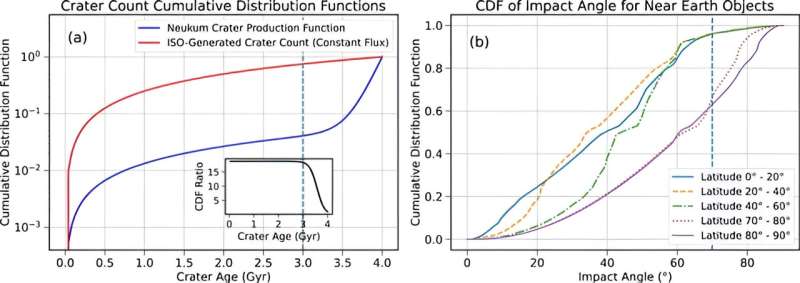By discovering two interstellar objects (ISOs), we know that asteroids and comets from other star systems pass through the solar system from time to time. By inference, some of these must have crashed into the moon, creating impact craters. If we could study the impact sites, we might be able to learn about the star systems that they came from.
A new paper suggests there could be a way to determine which lunar craters came from interstellar object impacts. The authors say that young, small craters with high-melt volume near the moon’s equator are likely the best candidates for ISO-generated craters on the lunar surface.
The two landmark discoveries of ISOs have changed our thinking on what’s possible for the origins of objects in our solar system. Detecting the cigar-shaped body named ‘Oumuamua (2017) and the speedy rogue Comet 2I/Borisov (2019) suggest that these objects—which have somehow been ejected from other solar systems—can wander through the Milky Way, unattached to any star system, for hundreds of millions of years.
Astronomers say their detections—made possible by improved telescopes and observing techniques—implies a large population of such objects exist and that ISOs enter our solar system on a fairly regular basis. Estimates have ranged from one, to seven, to 21 and even 70 objects every year.
Even if just a few pass through every year, over time there has likely been ISO-generated craters on the moon. This new paper by Daniel Chang, Cheng-Han Hsieh, and Gregory Laughlin, published in Research Notes of the AAS, explores how different crater properties such as age, size, melt, and position can be used to search for ISO-generated craters on the lunar surface.
“We find that selecting young, small craters with a high volume of melt located away from the lunar poles increases the likelihood of association with a high-speed ISO by 100-fold as compared to selecting randomly, assuming high-speed ISO impacts generate melt,” the authors wrote.

Most craters on the surface of planetary bodies in our solar system were formed during the first heavy bombardment period about 4 billion years ago. Therefore, since about 95% of lunar craters were formed during the first billion years of the moon’s existence, and assuming a constant ISO flux, the scientists write that selecting young craters (Among that selection, the next criteria would be to search for craters formed from high-velocity impactors. This would be craters with diameter less than 300 m with visible high-impact melt pond. Impact melt is exactly what its name implies: surface rocks that were instantly melted due to a high-velocity impact from an asteroid or comet. Large volumes of impact melt can pool to form what’s known as crater-fill deposits, which over time hardens to form an entirely new rock.
Craters with impact melt ponds accounts for 15% of the crater population. Then, the authors say, discard all the craters that appear to be created by vertical impact and choose craters that nearer to the equator.
“In total, selecting craters that fit these constraints [crater age, size, melt, and latitude] results in a 100 times higher probability of association with a high-speed ISO as compared to selecting randomly,” the authors write.
But, they note, no one should expect that a large number of lunar craters are the result of ISO impacts, since “craters from other sources, however, still massively outnumber ISO-generated craters.”
Other studies have noted that impacts from ISOs could leave very distinct craters, and still others say that we should constantly monitor the moon for impacts that could be from ISOs. If we could find and one day study the remains of an object from another solar system would allow us to learn more about other star systems without having to undertake a lengthy and expensive interstellar robotic missions.
More information:
Daniel Chang et al, Constraints to Efficiently Find Interstellar Object Generated Craters on the Moon, Research Notes of the AAS (2023). DOI: 10.3847/2515-5172/ad0731
Provided by
Universe Today
Citation:
Some of the moon’s craters are from interstellar impacts. Can we tell which? (2023, November 10)
retrieved 10 November 2023
from
This document is subject to copyright. Apart from any fair dealing for the purpose of private study or research, no
part may be reproduced without the written permission. The content is provided for information purposes only.